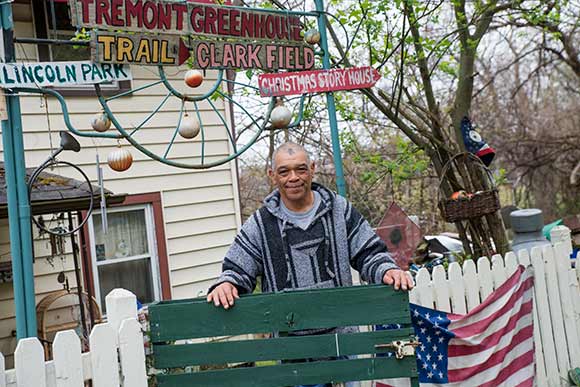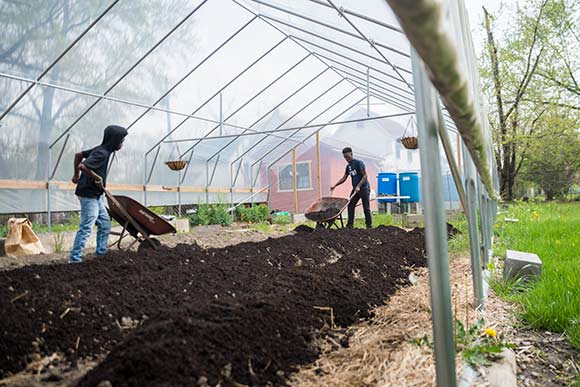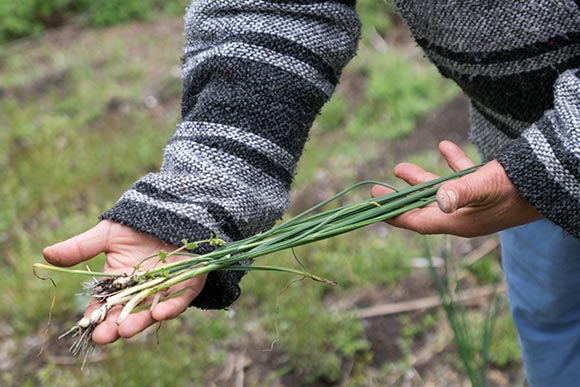Urban farms: small but mighty
So many of Cleveland’s neighborhoods are defined as food deserts, with just 25 percent of residents living within a five-minute walk to a full service grocery. Hence, thousands of area residents lack access to fresh fruits and vegetables and other resources to ensure healthy eating.
While agriculture and farming are not the first things that come to mind when defining Cleveland's urban neighborhoods, grass-root efforts at points across the city aim to turn those food deserts into oases of fresh produce.
“When you think about small urban farms, you’re creating healthy human habitats that lead to sustainable environments,” says Destinee Henton, community outreach coordinator for Ohio City Inc., which oversees Ohio City Farm. “Being in an urban environment like Cleveland, there is so much food imported from other areas. [Urban farms] are reclaiming areas where we’re able to eat food from the land.”
Three Cleveland farmers in particular are offering up the food they grow on their compact urban plots. Not only are they solving the problem of food access, they are teaching the next generation how to grow their own food and the importance of nutritious food and a healthy lifestyle.
A House of Sun
After a 30-year career in healthcare, Tanya Holmes was forced to retire because of back problems. She began looking for a way to assuage her depression and began making gift baskets. Then after seeing the needs of the Central neighborhood while working on the 2008 Obama campaign, Holmes got into farming.
In 2010 Holmes talked to a friend about taking over her half-acre plot of land. “It was looking like one of those abandoned [properties] and the city was trying to take it,” she recalls of the parcel at 2251 E. 73rd St. “It was filled with tires, trash, broken windows and the grass was overgrown.”
 Ka-La Healing Garden and Resource Center
Ka-La Healing Garden and Resource Center
Holmes convinced her friend to give her the land. “I took a fold-up chair and sat in the middle of it and thought, what can I do with this,” she says. “I saw kids walking by, prostitutes walking by. Drugs were being sold. No wonder no one wanted to go out.”
With that observation and her husband’s landscaping knowledge, Holmes set out to change the Central neighborhood with Ka-La Healing Garden and Resource Center in 2011.
Named after the Hawaiian mountain, Haleakala, which means “house of sun,” Holmes’ garden grows eggplant, tomatoes, zucchini, cucumbers, lavender, ginger and more on her tidy half-acre. There are picnic tables, and a meditation area. Holmes also runs a farm stand from 9:30 a.m. to 2:30 p.m. on Saturdays in the summer.
Holmes has transformed the neighborhood through her garden and has become a pillar of the Central community, serving as president of the E. 73rd Street Block Club, cleaning up the area and working with police in the Third District to reduce crime. “Now that I’m there, there is no crime on the street, thank God, and I’m friends with the police in my district,” she says. “As we started, there is unity in the community and people started coming out.”
Holmes received a grant from Farm Credit Mid-America to build a sign and hire Amish workers to build a shed on the lawn. Last year, the State of Ohio gave Holmes the Minority Small Farmer of the Year award for her efforts.
When she first started, Holmes was giving away her food to people in her neighborhood who said they couldn’t afford to buy it. “Over the years people would say ‘Miss Holmes we can’t afford vegetables,’ so I’d give it to them,” she says.
Starting this summer, Holmes will be able to accept the SNAP (supplemental nutrition assistance program) card and food vouchers given to senior citizens on a fixed budget.
Furthermore, last summer, Holmes employed 30 students in the Youth Opportunities Unlimited (Y.O.U.) summer jobs program, teaching them about gardening. “At first they didn’t know what an eggplant was,” she laughs. “They said, ‘what’s that purple thing.’ We taught them how to do a raised bed, a flowerbed. Whatever was needed on 73rd Street, we did it.”
 Tanya Holmes grandkids helping out at Ka-La Healing Garden
Tanya Holmes grandkids helping out at Ka-La Healing Garden
But Holmes also got something back from the Y.O.U. students. “I teach the kids that people live here,” she says. “Where ever you live you have to keep clean. Teaching them was the really big thing. I didn’t realize how big it was. To see their faces when a zucchini came out of the ground, or a deer on the other side of the fence, it’s just so awesome.”
Holmes also taught the students the importance of eating healthy, how to identify seeds and other sustainable practices such as how to compost. She even had them bring in their own food scraps for the compost pile. This summer Holmes will host 12 Y.O.U. students.
Holmes also partners with the Greater Cleveland Food Bank, providing Sunday lunches to Y.O.U. participants and other youngsters in the neighborhood.
Members of Cleveland City Council and officials from Washington, D.C. have come to view Holmes’ success at Ka-La Healing Garden. The center has even been a stop on a Lolly the Trolley Tour, during which Holmes handed out bags of basil.
Healthy Food, Reasonable Prices and a Side of History
Ever since she was a child, Blayne Hoerner Murray has enjoyed gardening.
As an adult, she's worked at community gardens and gotten involved with the Coit Road Farmers Market in East Cleveland. Hence when the Coit Road Market board president asked her if she would like to be part of the co-op program across the street, the Cleveland Heights resident jumped at the chance. For the past four years she’s been running High Hoe Farm and Sundries on part of the 1.75 acres that formerly served as an overflow parking lot for Coit, which is the oldest farmers market in Cleveland, dating back to 1932.
 High Hoe Farm and Sundries
High Hoe Farm and Sundries
Hoerner-Murray tends to 26 raised beds on the land with partner Karen Pappaleo Shumaker. “I’m not a morning person so she comes in early,” says Hoerner Murray. “She sits in the booth at the market and I run around weeding.” A third farmer, Gloria Jalil, tends to her own beds on the land and also has a stand at the market.
By growing things like herbs, carrots, radishes, tomatoes and lettuce, High Hoe is able to provide food in an area with poor food access. “It serves a need,” she says. “The grocery stores around here really suck and a lot of people get food at convenience stores and it’s not great food.”
Hoerner Murray tries to grow produce that interests the Coit Road Market patrons. “I try to learn more about what our customers want, like the old Russian ladies who come in first thing in the morning,” she says, adding that she’s always on the lookout for pepper varieties that attract her Latino customers. “We try to find produce interesting to them.”
Hoerner Murray's claim to fame is her shishito peppers, which are Japanese sweet peppers that occasionally have a spicy one in the bunch. “It’s not a hot pepper, but one in every dozen or so will be hot, so it’s kind of Russian roulette,” she says, adding that one year when she grew the peppers from the previous season’s seeds, she wound up with something that resembled a cross between a shishito and a jalapeno pepper. “I called them ‘ohshito peppers,’” she jokes.
But the bottom line is providing produce that can’t otherwise be easily found in the neighborhood. “We have healthy food at a reasonable price,” she says, “I feel like I’m doing something good there. I love the people there and it’s just a special place to me.”
In the winter months Hoerner Murray and Pappaleo Shumaker sell homemade products like skin salve, lip balm, soap and fruit leather, which provides the means to operate year-round.
"This is an imagination farm."
In 1994 Erich Hooper was looking for a way to pay for his daughter’s education at St. Mark’s School. “So I started cutting down trees and started growing food,” he recalls. The former chef began farming on his one-acre plot on 2835 W. 11th St. in Tremont.
With that, Hooper’s Farm was born and Hooper takes credit for founding more than 12 farmers markets, festivals and fairs throughout the city. He’s been a Tremont resident since 1966, having moved to the neighborhood after the Hough riots. “We were the third black family in the neighborhood,” he recalls.
You name it; Hooper grows it. His favorites are kale, Swiss chard and collard greens – the staples in his famous vegetable stir fry wraps. “There are 10 to 12 different ways you can make meals with those and you can drink them,” he explains. “They’re healthy, hardy, grow all winter and come back the next year.”
 Erich Hooper of Hooper Farm
Erich Hooper of Hooper Farm
While Hooper runs a farm stand in front of his house, he doesn’t sell his produce at the farmers markets and festivals any more, citing the politics and fees associated with many of the organizations.
His efforts over the years have also attracted schools and neighborhood kids. Ever since he started the farm, Hooper’s goal has been to educate area youth about where food comes from and how to grow.
“There’s nothing more pleasurable to me than seeing a kid picking something out of the garden and eating it,” he says. Although school groups don’t come as often these days, Hooper still has a steady stream of Cleveland kids coming to visit.
He hands each child a seed at the beginning of the summer to plant, grow, harvest and teach them about the circle of life. Those who come to pitch in listen to bluegrass or classical music while helping work the soil and grow “everything from A to Z,” Hooper says. “We’re raising future farmers and citizens.”
He operates Hooper’s Farm entirely from his own funds and donations from community members and friends. He also periodically solicits investments from celebrities such as Steve Harvey, Arsenio Hall and Oprah Winfrey; and local chefs Michael Symon, Rocco Whalen and Ricardo Sandoval.
The Cavaliers fan and former mascot even recently contacted LeBron James, in hopes that the common mission of helping Northeast Ohio children create quality lives for themselves would spur his foundation to make a donation. He has yet to hear word.
Even if the kids don’t have an interest in farming, Hooper will find something for them to do. “At this homegrown circus that is Hooper’s Farm, everybody has a role,” he says. “Every kid doesn’t want to grow food, I get that. But I can steer them in the right direction because I know people.”
For instance the farm sells coffee mugs and bowls his students crafted at friend Teresa Skaggs Polk’s Pottery and Clayworks Studio in Parma. Also for sale at the farm are the musical walking sticks Hooper taught the kids to craft out of branches and beer bottle caps donated by the neighborhood bars.
“If this is your dream, we’re going to get you started on your dream at a young age,” says Hooper. “This is imagination farm.”
















